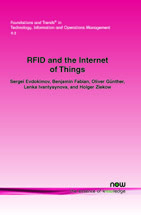RFID and the Internet of Things: Technology, Applications, and Security Challenges
By Sergei Evdokimov, gematik, Gesellschaft für Telematikanwendungen der Gesundheitskarte mbH, Germany, sergei.evdokimov@gematik.de | Benjamin Fabian, Institute of Information Systems, Humboldt-Universität zu Berlin, Germany, bfabian@wiwi.hu-berlin.de | Oliver Günther, Institute of Information Systems, Humboldt-Universität zu Berlin, Germany, guenther@wiwi.hu-berlin.de | Lenka Ivantysynova, Universität Potsdam, Germany, ivantysynova@cs.uni-potsdam.de | Holger Ziekow, Institute of Information Systems, Humboldt-Universitä zu Berlin, Germany, ziekow@wiwi.hu-berlin.de
Abstract
Radio Frequency Identification (RFID) has started to exert a major influence on modern supply chain management. In manufacturing, RFID changes the way objects are tracked on the shop floor and how manufactured goods interact with the production environment. In logistics, RFID is used to track and trace pallets or individual objects on a global scale. In retail, RFID is used to identify objects, retrieve related information, and prevent theft. Sometimes the tags remain attached to the objects post-sale, thus facilitating additional services. Overall, enterprises have much more detailed information about the objects: the use and produce, their location, their trajectories, and their physical state.
In this survey paper, we show how RFID has transformed the supply chain over the past decade, discussing manufacturing, logistics, and retail and related cost/benefit considerations. We also describe the vision of an "Internet of Things," where each participating object has a digital shadow with related information stored in cyberspace. We conclude with an extensive discussion of related privacy and security risks, including some of our own proposals to mitigate them.
RFID and the Internet of Things
RFID and the Internet of Things shows how RFID has transformed the supply chain over the last decade and examines the manufacturing, logistics and retail aspects of RFID. This monograph considers the related cost/benefit of RFID in these business environments. The authors describe a vision of an "Internet of Things", where each participating object has a digital shadow with related information stored in cyberspace. RFID and the Internet of Things introduces the reader to the relevant hardware and software as well as to standards and architectures. It then present several case studies and uses cases showing how RFID can be used in manufacturing and retail with a focus on intra-enterprise applications and local benefits. The authors move further down the supply chain, discussing RFID applications in logistics and the perspectives for an Internet of Things. This is followed by a discussion of cost/benefit analyses of RFID implementations. The volume discusses possible security and privacy risks of RFID and presents several architecture proposals for a less centralized Internet of Things. The authors conclude with a summary and outlook.
